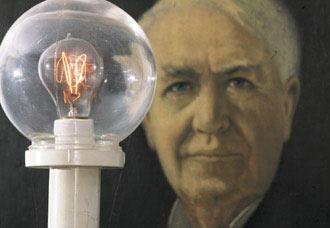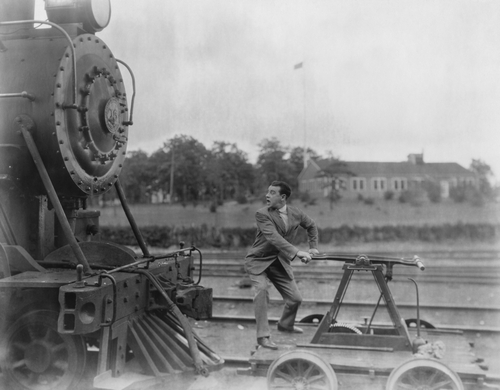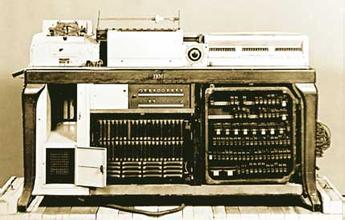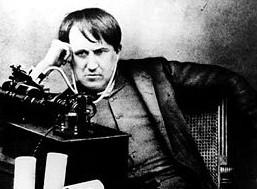A small town in the Midwest was the birthplace of one of the most inventive geniuses of the late 19th and early 20th centuries. Born in Milan, Ohio on February 11, 1847, Thomas Alva Edison suffered through several illnesses during his infancy and toddler years. The youngest of seven siblings, Edison wasted little time making his presence in the world known.
19世纪末20世纪初,在美国中西部的一个小镇诞生了一位极具发明精神的天才。1847年2月11日,爱迪生降生于俄亥俄州的米兰镇。儿时的托马斯·阿尔瓦·爱迪生体弱多病。身为七个兄弟姐妹中最小的一个,爱迪生只用了很短的时间就功成名就。
Edison's formal schooling was limited, and by the age of 12 he had begun his working career. From that point forward, he never stopped working, inventing and creating. With well over 1000 patents to his credit, Edison prided himself on never giving up on an idea even when the final result proved unsuccessful. Edison's work was at times all consuming and his main concern. As his professional life was taking off, his personal life suffered a tragic blow. While his relationships with his older children suffered, Edison would later be given another chance at being a loving husband and father. Learn more about Thomas Edison with the following ten interesting facts about the his life and times.
爱迪生在校求学的时间非常短暂, 12岁就开始工作了,从那以后,就没停止过工作、发明和创造的步伐。他拥有1000多项专利,爱迪生为自己从不放弃一些想法而感到自豪,即便有些想法最终证明是错的。爱迪生的工作有时候会既耗时间又耗精力。正当他的事业蒸蒸日上之际,私人生活却遭受了严重的打击。虽然他与孩子们的关系受到影响,但是后来爱迪生又得到了一个成为有责任心的丈夫与父亲的机会。下面来看看有关爱迪生的生活和他那个时代的十个有趣事实吧。
10.Edison Was Home-schooled
10.爱迪生在家上学

Thomas Alva Edison was a sickly child. Between his illnesses and his family's move to Port Huron, Michigan, he was unable to begin school until the age of seven. Full of curiosity from a very early age, Edison was always asking questions and had difficulty keeping his attention focused on the task at hand. He was unable to sit still for very long and was uncomfortable with the school's rigid environment.
小时候的托马斯·阿尔瓦·爱迪生体弱多病。在他生病和全家搬到密歇根休伦港期间都没能步入学堂,直到七岁时才开始上学。爱迪生很小的时候就对一切充满好奇,他会问很多问题,并且很难把注意力集中到自己手头的事物上。他也很难长时间端正坐姿,对于学校严格的规范总是感觉很不自在。
After attending school for only 12 weeks, Edison had established himself as a difficult student, and his teacher deemed him unmanageable. Upon learning of this characterization of her son, Edison's mother was very angry. A former teacher herself, Mrs. Edison quickly removed him from the school and assumed the role of home school educator. Nancy Edison supported her son's insatiable thirst for knowledge. By teaching her son reading, writing and arithmetic and allowing him to pursue any subject of interest, Mrs. Edison helped him to channel his energy in a positive direction. He began to realize that his learning possibilities were endless and he could actually teach himself anything he wished. This set him on a path of constant self-improvement which he continued throughout his life. Edison credited his mother for shaping the person he became. Edison never returned to formal schooling. At the age of 12 he began operating a newsstand aboard a railroad train that ran between his hometown of Port Huron and Detroit. Wishing to make use of every moment, Edison set up both a printing press and laboratory in an unused rail car where he could be found in his spare time.
仅仅上学12周之后,爱迪生就认为自己不太适合呆在学校,老师也认为他难以管理。听了老师对自己孩子相关情况的描述之后,爱迪生的母亲非常生气,由于爱迪生的母亲以前也是一位老师,所以她立马让爱迪生离开学校,并充当起了家庭教师的角色。爱迪生的母亲南希·爱迪生非常支持爱迪生对知识求知若渴的态度。在教授阅读,写作以及算数、并且允许他钻研自己感兴趣的学科的同时,爱迪生的母亲还引导他向积极的方面努力。爱迪生开始意识到自己学习的潜力巨大,能自学他想学的任何东西。这一点让他一生都在自我提升的道路上不断前进,爱迪生称赞道是他的母亲造就了今日的自己。爱迪生后来再也没有去学校上学。12岁就开始在往返于自己的家乡休伦港和底特律的火车上经营报刊亭。为了充分利用每分每秒,爱迪生还利用自己业余时间在一辆废旧火车上配备印刷机和实验室。
9.Edison Was Almost Totally Deaf
9.爱迪生几乎完全失聪

One of the country's most prolific inventors, Thomas Edison achieved great success while suffering from a severe disability for much of his life. While the exact cause is unclear, Edison's sense of hearing began to decline at the age of 12. Although his father and one of his son's suffered from hearing loss as well, indicating it was a genetic condition, there were several incidents in his life that may have made the disability even worse.
虽然听力障碍给他的生活带来不便,但是发明大王托马斯·爱迪生还是取得了巨大的成就。12岁时爱迪生的听觉能力开始下降,然而造成听力差的具体原因还不是很清楚。他的父亲和他的一个儿子同爱迪生一样也受到听力障碍的困扰,这也就暗示了他的听觉障碍是遗传引起的。而生活中的意外事故可能让他听觉能力变得更弱。
Edison suffered from scarlet fever, and it is suspected that he had numerous untreated ear infections since there were no antibiotics available at the time for that condition. It is also reported that a train conductor struck Edison on both ears as punishment for one of his experiments causing a fire on the railroad train. Edison himself believed his disability may have been caused when someone, attempting to keep him from falling off a moving train, grabbed him by the ears. Edison claims to have felt something click in his inner ear and began having hearing difficulties after that. Many were surprised that Edison did not help his own cause by inventing an effective hearing aid. While Edison did dabble in it for a bit, his efforts were far less than wholehearted. By his own admission, Edison actually saw his hearing loss as a positive thing. He claimed it allowed him to get much better sleep than most. He also felt it eliminated distractions while he was working. He was able to drown out the constant noise of everyday conversations and was thus able to work more efficiently.
爱迪生曾经患过猩红热,由于当时还没有抗生素治疗猩红热,导致耳部大面积感染。据说爱迪生在某次实验中致列车着火,火车管理员便扇他巴掌以示惩戒。爱迪生自己认为他糟糕的听觉能力是当时一个人防止他掉下飞驰的火车而揪住他的耳朵造成的。他也承认当时感觉耳朵内部像被针扎了一样疼,从那以后听力就出现问题。很多人对于爱迪生没有发明一个帮助自己改善听力的设备而感到奇怪。然而爱迪生确实对此有所涉猎,但是他并没有全心全意的投入。在他自己看来,听力障碍实际上是件好事,这样会让他的睡眠质量比大多数人高;也可以帮助他在工作时集中注意力,使他可以在嘈杂的环境中更高效的工作。
8.Edison's Heroics Helped Launch His Career
8.爱迪生的英勇之举助他开启职业生涯

By 1862, Thomas Edison was already an entrepreneur and the publisher of a small newspaper. Only 15 years of age, he had spent much of the previous three years experimenting with chemicals and anything else he could get his hands on. He was proud of each success but learned even more from each failure and continued his quest for knowledge.
1862年时,托马斯·爱迪生已经是一位企业家以及一家小型报社的出版商。年仅15岁的爱迪生在过去三年的大部分时间里都在做化学实验及各种能做的其他实验。他为自己取得的每一次成功而自豪,然而失败让他收获更多。无论成功还是失败,都激励着他不断追求新的知识。
As fate would have it, Edison experienced a life-changing moment at the very tracks on which he had spent his early teen years. Jimmie MacKenzie, the three-year old son of a railroad station master, had wandered away and ended up on the railroad tracks. Edison, who just happened to be at the Mount Clemens Train Depot that day saw a runaway train bearing down on the child. Realizing he had to do something, Edison managed to push the little boy out of harm's way just before the train reached them. When the boy's father realized what Edison had done, he tried to think of a way to adequately repay him for his heroism. He decided to teach Edison all about railway telegraphy, leading to a full-time job for the teenager. For the next five years, Edison traveled across the country as a telegrapher. The need for skilled telegraph operators was great as the Civil War was underway. Not one to be satisfied doing the same thing over and over, Edison began working on the telegraph equipment in attempts to improve its performance. After returning to Michigan for a short time, Edison left for the east coast. He was confident by this time that he could make a living as an inventor. He settled in Boston, Massachusetts, where he submitted his first patent.
在命运的安排下,爱迪生青年时期发生了一件改变其一生的事情。一次,一位铁路站站长的3岁儿子吉米·麦肯齐在铁轨附近玩耍结果跑到了铁轨上。当时,爱迪生恰好在克莱门斯山车务段,他看见一辆飞驰的列车正向那可怜的孩子驶来。此时的爱迪生意识到自己必须立刻做些什么。就在列车到达之前,他冲上前去成功将那小男孩带离了危险。当男孩的父亲了解到爱迪生的举动后,他很想回报爱迪生的英勇行为。于是他决定教给爱迪生关于铁路电报的知识,并且给了这位年轻人一份全职工作。在接下来的五年里,爱迪生作为一名报务员奔波于全国各地。当时正处于美国内战,对于高技能报务员的需求非常大。然而爱迪生并不是一个满足于不断重复做同一件事情的人。他开始研究电报设备,试图改良其性能。回到密歇根不久后,爱迪生又去了东海岸。那时的他相信自己能够以一名发明家的身份谋生。他在马萨诸塞州的波士顿安定了下来并提交了自己的第一份专利申请。
7.Edison Designs A Vote Tabulating Machine
7.爱迪生设计了一台投票制表机

Soon after arriving in Boston, Edison, along with other inventors, began working on ways to assist state and federal legislative bodies work more efficiently. He concentrated his efforts on a way to quickly and accurately tabulate votes placed on various pieces of legislation. Legislation was deemed either passed or not passed on the sole basis of a voice vote. Edison believed he could invent a machine that would be much more objective in its counting. In 1868, he submitted his first patent request for an Electrographic Vote Recorder.
在抵达波士顿后不久,爱迪生连同其他发明家开始研究如何协助各州与联邦立法机构更有效地工作。他集中精力研究一种能快速准确地将不同议员的投票制表的方法。原先,立法是基于口头表决的,其结果只有通过或者不通过。爱迪生相信自己能发明一种机器,使得票数统计更为客观。1868年,他为自己的电子投票记录仪提交了第一份专利申请。
Edison's invention consisted of a device on which all legislator's names were listed. When placing a vote, the legislators would move a switch to a "yes" or "no" position which would then record via electric impulse and transfer to a chemically treated paper providing a printout of each vote cast. A colleague of Edison named Dewitt Roberts was intrigued by the machine and paid Edison $100 for a share in its revenue. Convinced the invention would be welcomed, Roberts took it and presented it to the members of Congress in Washington, D.C. To both men's surprise, the invention was not enthusiastically received. Legislators were not anxious to have votes tabulated so quickly as they believed it would interfere with their ability to sway voters, make deals and use a filibuster to change outcomes. Unable to drum up any interest in his invention, Edison abandoned the production of the vote recorder. He did, however, learn a valuable lesson going forward. He made a vow to himself never to work on a product that he wasn't sure the public had an interest in.
爱迪生的这项发明包括一台能够将所有投票议员名字列出的设备。在唱票表决时,投票者按下电钮,切换到"是"或"否"的位置,机器将通过电脉冲记录并将结果转到化学处理过的纸张上,从而将每张选票打印出来。爱迪生的一位名叫德威特·罗伯茨的同事对这一发明很感兴趣,于是支付其100美金来换取这项发明未来收益的部分收益。罗伯茨相信该发明将受到广泛欢迎,于是把它呈给了位于华盛顿的国会议员们。令两人吃惊的是,此发明并没有被议员们广泛接受。立法者们并不急于将投票制表,因为他们认为这会妨碍他们动摇选民、进行内幕交易以及通过阻挠议案通过来改变结果。由于对自己的这一发明失去了兴趣,爱迪生放弃生产投票记录仪。然而,他在前进的道路上却学到了宝贵的一课。他发誓,自己不再研究任何无法使公众产生兴趣的发明。
6.Edison Opens Research And Development Center In New Jersey
6.爱迪生在新泽西州建立了开放性研发中心

After a few unsuccessful ventures while still in Boston, Thomas Edison began losing investors. He decided to move to New York as he had been working on an improved stock ticker machine. To his delight, Western Union, his employer, offered to purchase all of his machines for $40,000. This was enough to set up business in a Newark, New Jersey warehouse. The business produced improved telegraphic and stock ticker equipment while Edison was hard at work on new ideas. He fell in love with one of his employees, 16 year-old Mary Stilwell, and married her in 1871.
在波士顿经历了几次失败的投机后,爱迪生开始失去投资者。因为一直在改良股票机,所以他决定搬到纽约去。令他高兴的是,他的雇主西部联盟电报公司斥资40000美金购买了他所有的机器,这些钱足够他在新泽西州纽瓦克市的仓库里创业了。当爱迪生在努力地构思新点子时,那些商人将改良的电报机和股票机投入生产。在此期间,他爱上了他的一位员工——年方16的玛丽·史迪威,并于1871年与她步入婚姻的殿堂。
In 1875, Edison felt he had outgrown the warehouse in Newark and purchased land in the small town of Menlo Park, New Jersey. With the help of his father, Edison built not only a main laboratory, but other specific use buildings as well. Edison officially moved the business out of Newark in 1876. Menlo Park was the first research and development center of its kind in the United States. Many of Edison's greatest inventions occurred here, and he became fondly known as "The Wizard of Menlo Park." Edison himself named the site "Invention Factory" in 1878. He certainly put this small town in New Jersey on the map. Meanwhile, Edison also moved his wife and two children, Marion and Thomas Alva Jr. to Menlo Park. His third child, William, was born two years later. Though they were close by, Edison was so engrossed in his work that he spent little time at home. His relationships with his family, particularly his children, suffered as a result.
1875年,爱迪生觉得他的事业已经发展成熟不用再在纽瓦克市的仓库里待着了。于是他在新泽西州门洛园的一个小镇上买了地。在父亲的帮助下,爱迪生盖了一栋主实验室大楼和几栋特殊用途楼。1876年,爱迪生正式地将自己的事业搬出纽瓦克市,而门洛园是他在美国的第一处研发中心。爱迪生的许多伟大发明都诞生于此,他也以"门洛园奇才"而名扬千里。1878年,爱迪生将其命名"发明工厂"。也正是他让这个在新泽西州的小镇日渐为世人熟知。同时,爱迪生也带着妻子与两个孩子——马里恩和小托马斯·阿尔瓦搬到了门洛园。第三个孩子威廉也在两年后出生了。虽然他们拉近了距离,但是爱迪生十分专注于工作,很少回家。也因此而影响了他和家人的关系,尤其是和孩子们关系。

















